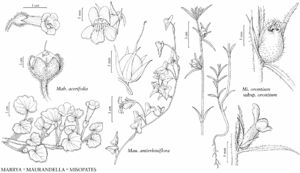Maurandella antirrhiniflora
Feddes Repert. Spec. Nov. Regni Veg. 52: 27. 1943.
Perennials vines, 50–300 cm. Leaves glabrous; petiole 5–45 mm; blade hastate to sagittate, 5–30 × 4–35 mm. Pedicels ascending, winged, 10–45 mm, glabrous. Flowers: sepals subequal, adaxial lateral pair falcate, 9–14 × 2–3 mm, apex acute, surfaces glabrous; corolla-tube 13–17 mm, glabrous externally, throat closed, palate inflated and streaked with white, yellow, or violet, puberulent to villous, lobes rounded, 4–8 mm, abaxial lobes projecting, adaxial erect; stamens included, filaments incurved, yellow-villous basally, abaxial 9–12 mm, adaxial 11–14 mm, pollen-sacs oblong; ovary septum V-shaped, locules unequal; style terete, included, 10–13 mm, stigma recurved. Capsules globular, 7–10 mm, glabrous, larger locule dehiscing first. Seeds 1–1.5 mm, surfaces cristate-tuberculate. 2n = 24.
Phenology: Flowering Feb–Dec.
Habitat: Canyons, rocky slopes, arroyos, coastal dunes, desert flats on siliceous, calcareous, gypseous substrates.
Elevation: 0–1800(–2600) m.
Distribution
Ariz., Calif., Nev., N.Mex., Tex., Mexico
Discussion
Maurandella antirrhiniflora has been treated either as one of two species in Maurandella (along with M. hederifolia) (W. Rothmaler 1943; D. A. Sutton 1988), or as one species with M. hederifolia treated at subspecific rank (W. J. Elisens 1985). Maurandella antirrhiniflora is recognized here without infraspecific variants to be consistent with the pattern of interspecific variation in Antirrhineae. Variable floral coloration is present in central Arizona and California, with pink and red corolla morphs occurring in discrete populations from the widespread blue to violet morphs.
Selected References
None.
